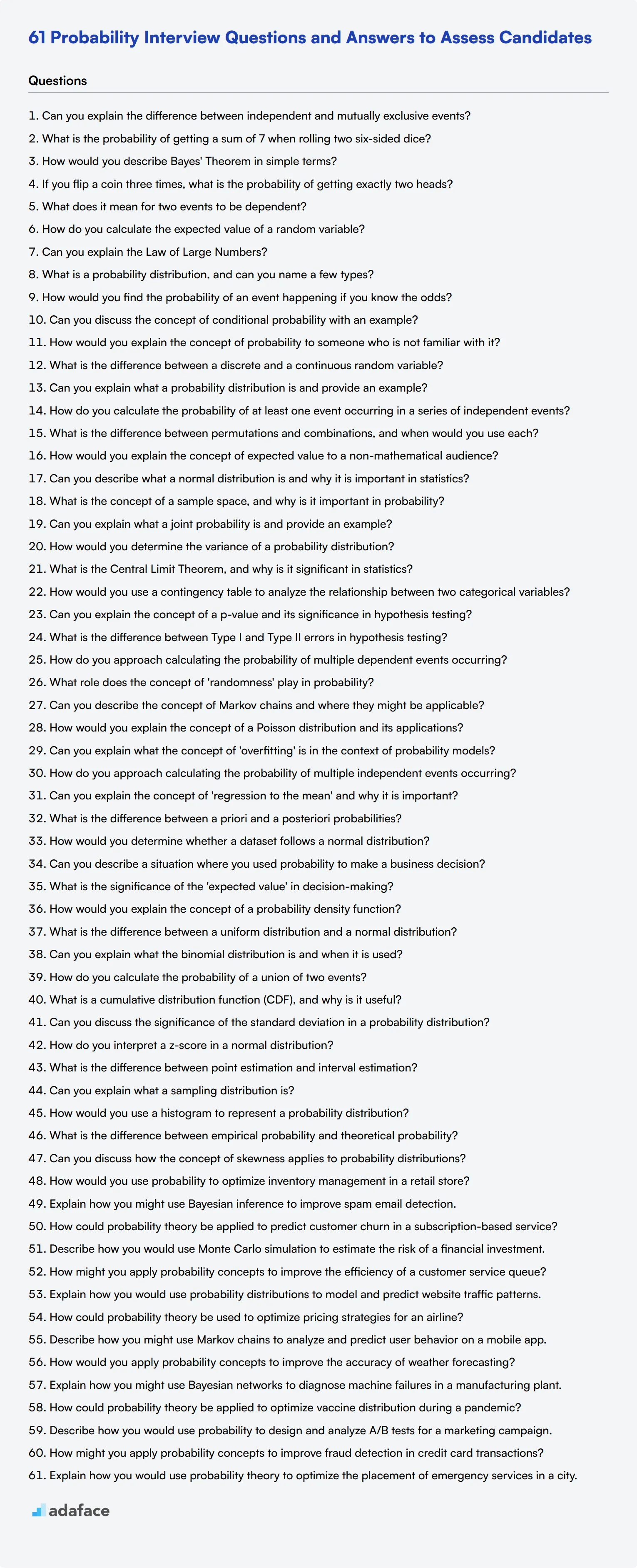Assessing a candidate's probability skills is crucial for roles in data science, analytics, and risk management. Interviewers need a comprehensive set of questions to evaluate applicants' understanding of probability concepts and their ability to apply them in real-world scenarios.
This blog post provides a curated list of probability interview questions and answers, tailored for different experience levels and job roles. From basic concepts for entry-level positions to advanced topics for senior analysts, we cover a wide range of probability-related questions, including those tied to statistical concepts and practical applications.
By using these questions, recruiters can effectively gauge candidates' proficiency in probability and make informed hiring decisions. For a more thorough evaluation of candidates, consider combining these interview questions with a standardized probability assessment test.
Table of contents
10 basic Probability interview questions and answers to assess candidates

To assess whether your applicants have a solid grasp of basic probability concepts, ask them some of these interview questions. These questions help you evaluate essential skills that are critical for roles such as data scientist, ensuring candidates can tackle fundamental probabilistic problems.
- Can you explain the difference between independent and mutually exclusive events?
- What is the probability of getting a sum of 7 when rolling two six-sided dice?
- How would you describe Bayes' Theorem in simple terms?
- If you flip a coin three times, what is the probability of getting exactly two heads?
- What does it mean for two events to be dependent?
- How do you calculate the expected value of a random variable?
- Can you explain the Law of Large Numbers?
- What is a probability distribution, and can you name a few types?
- How would you find the probability of an event happening if you know the odds?
- Can you discuss the concept of conditional probability with an example?
7 Probability interview questions and answers to evaluate junior analysts
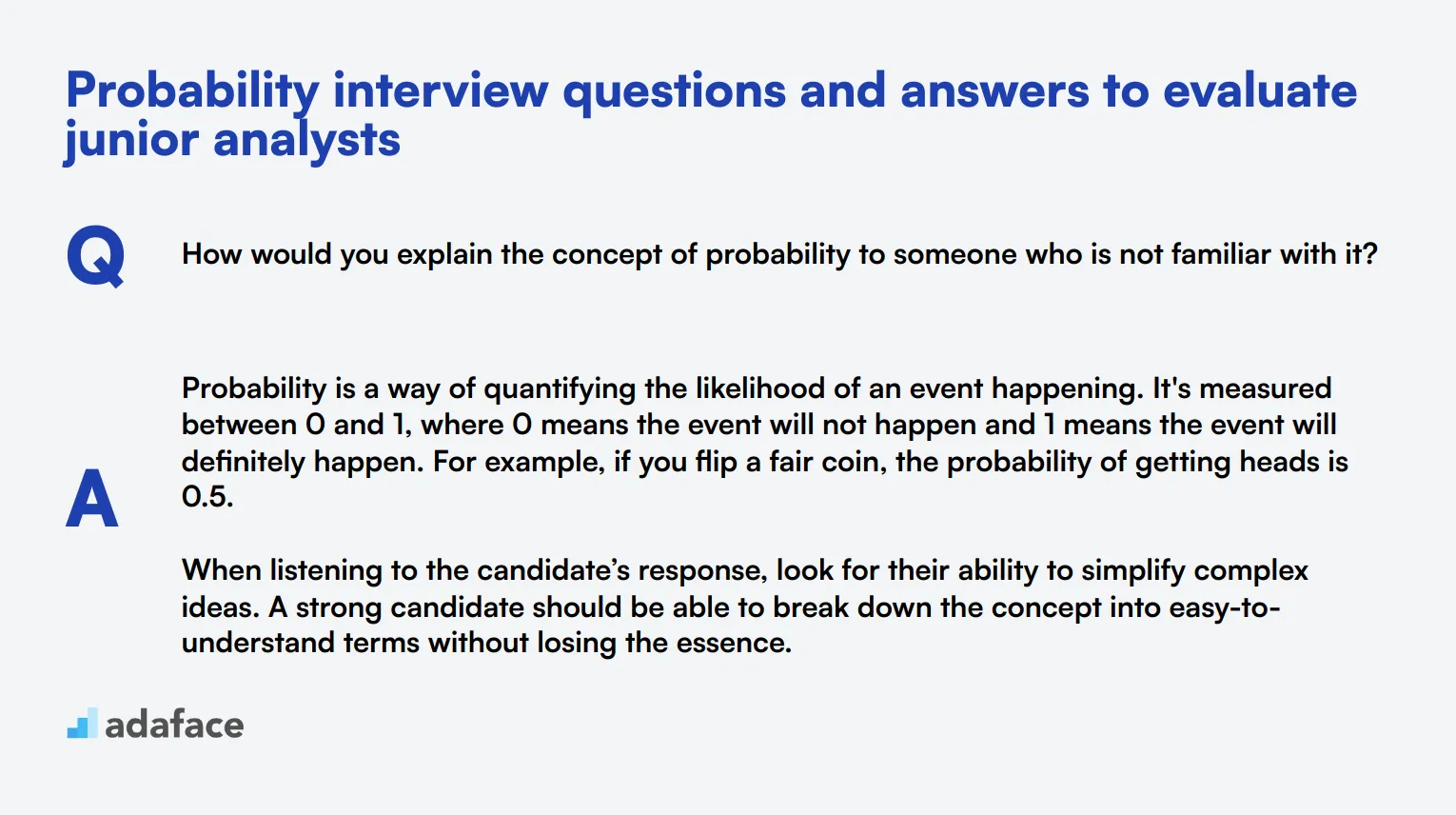
To determine if your junior analysts have a solid grasp of foundational probability concepts, consider using these practical interview questions. They are designed to test candidates' understanding in a straightforward manner, making your hiring process more effective.
1. How would you explain the concept of probability to someone who is not familiar with it?
Probability is a way of quantifying the likelihood of an event happening. It's measured between 0 and 1, where 0 means the event will not happen and 1 means the event will definitely happen. For example, if you flip a fair coin, the probability of getting heads is 0.5.
When listening to the candidate’s response, look for their ability to simplify complex ideas. A strong candidate should be able to break down the concept into easy-to-understand terms without losing the essence.
2. What is the difference between a discrete and a continuous random variable?
A discrete random variable is one that can take on a countable number of distinct values, such as the result of rolling a six-sided die. A continuous random variable, on the other hand, can take on an infinite number of possible values within a given range, such as the exact weight of an apple.
Ideal answers should highlight these distinctions clearly. Candidates should also provide examples to illustrate their understanding. Follow up with questions to see if they can apply these concepts to real-world scenarios.
3. Can you explain what a probability distribution is and provide an example?
A probability distribution describes how the values of a random variable are distributed. It shows all possible values the variable can take and how likely each value is. For example, in a fair dice roll, the probability distribution is equal for all six outcomes, each having a probability of 1/6.
Look for explanations that convey a clear understanding of the concept and its practical applications. The candidate should relate their explanation to specific examples, demonstrating a well-rounded grasp of the topic.
4. How do you calculate the probability of at least one event occurring in a series of independent events?
To calculate the probability of at least one event occurring, you can use the complement rule. First, calculate the probability that none of the events occur, and then subtract that from 1. For example, if you have two independent events, each with a probability of 0.3, the probability that neither event occurs is (1 - 0.3) * (1 - 0.3) = 0.49. Hence, the probability of at least one event occurring is 1 - 0.49 = 0.51.
Candidates should demonstrate a clear understanding of the complement rule and be able to apply it correctly. They should also provide a specific example to show their practical understanding.
5. What is the difference between permutations and combinations, and when would you use each?
Permutations refer to the arrangement of items where the order matters. Combinations refer to the selection of items where the order does not matter. You use permutations when the sequence is important, such as in a race where finishing first, second, and third matters. You use combinations when the sequence doesn’t matter, like picking three fruits from a basket.
Strong candidates will clearly differentiate between the two concepts and provide appropriate examples. They should also explain the practical applications of each to demonstrate a deeper understanding.
6. How would you explain the concept of expected value to a non-mathematical audience?
Expected value is like the average outcome you would expect from a random event if you could repeat it many times. It’s a way to predict the long-term result. For example, if you flip a coin, you’d expect to get heads about half the time, so the expected value of heads in a single flip is 0.5.
Look for candidates who can simplify this concept without losing its meaning. They should be able to provide relatable examples and make the concept easy to understand for someone without a mathematical background.
7. Can you describe what a normal distribution is and why it is important in statistics?
A normal distribution is a bell-shaped curve where most of the data points are concentrated around the mean. It’s symmetric, meaning the left side of the mean is a mirror image of the right. This type of distribution is important because many statistical tests assume data follows a normal distribution, making it easier to make inferences about populations.
Candidates should provide a clear and concise explanation of the normal distribution and highlight its significance in statistical analysis. They should also be able to reference its common applications, such as in data analysis.
10 intermediate Probability interview questions and answers to ask mid-tier analysts
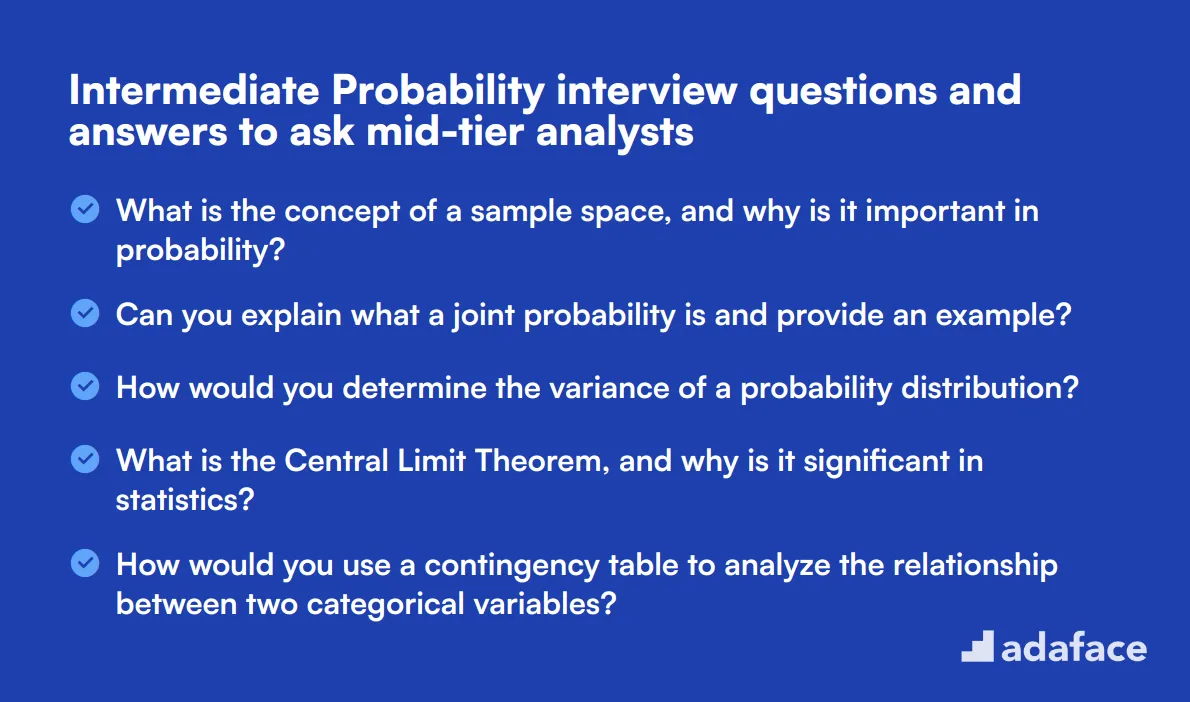
To evaluate whether your candidates possess a solid grasp of probability concepts, consider using this list of intermediate questions tailored for mid-tier analysts. These inquiries can help you uncover their analytical skills and ability to apply probability in real-world scenarios, especially for roles like a data analyst.
- What is the concept of a sample space, and why is it important in probability?
- Can you explain what a joint probability is and provide an example?
- How would you determine the variance of a probability distribution?
- What is the Central Limit Theorem, and why is it significant in statistics?
- How would you use a contingency table to analyze the relationship between two categorical variables?
- Can you explain the concept of a p-value and its significance in hypothesis testing?
- What is the difference between Type I and Type II errors in hypothesis testing?
- How do you approach calculating the probability of multiple dependent events occurring?
- What role does the concept of 'randomness' play in probability?
- Can you describe the concept of Markov chains and where they might be applicable?
8 advanced Probability interview questions and answers to evaluate senior analysts
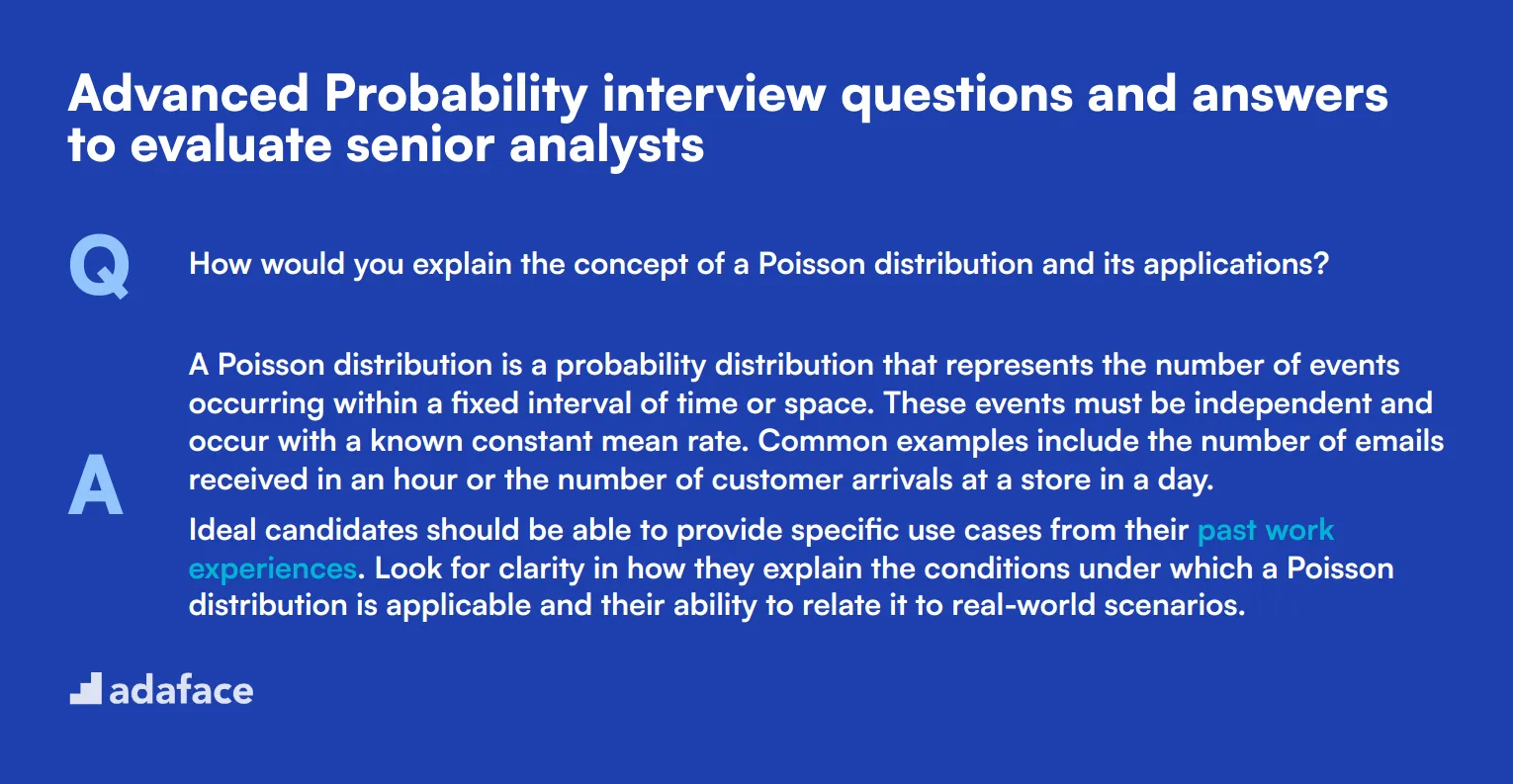
To determine whether your senior analyst candidates have the advanced probability skills required for high-stakes decision-making, pose these challenging questions during your interviews. Designed to reveal depth of understanding and practical application, these questions will help you identify true experts.
1. How would you explain the concept of a Poisson distribution and its applications?
A Poisson distribution is a probability distribution that represents the number of events occurring within a fixed interval of time or space. These events must be independent and occur with a known constant mean rate. Common examples include the number of emails received in an hour or the number of customer arrivals at a store in a day.
Ideal candidates should be able to provide specific use cases from their past work experiences. Look for clarity in how they explain the conditions under which a Poisson distribution is applicable and their ability to relate it to real-world scenarios.
2. Can you explain what the concept of 'overfitting' is in the context of probability models?
Overfitting occurs when a probability model is too complex and captures the noise along with the underlying pattern in the data. This often results in excellent performance on training data but poor generalization to new, unseen data. It’s a common issue in predictive modeling where the model has too many parameters relative to the number of observations.
Look for candidates who can not only define overfitting but also discuss strategies to prevent it, such as cross-validation, regularization, or simplifying the model. Their ability to balance model complexity with predictive accuracy is a good indicator of their practical experience.
3. How do you approach calculating the probability of multiple independent events occurring?
To calculate the probability of multiple independent events occurring, you multiply the probabilities of each individual event. For example, if the probability of Event A occurring is 0.3 and the probability of Event B occurring is 0.5, then the probability of both events occurring is 0.3 * 0.5 = 0.15.
An ideal candidate will not only perform this basic calculation but will also discuss the assumptions of independence and provide examples where this method is applicable. Follow up by asking them to explain scenarios where events are not independent and how the calculation changes.
4. Can you explain the concept of 'regression to the mean' and why it is important?
Regression to the mean is a statistical phenomenon where extreme observations tend to be closer to the average on subsequent measurements. This occurs because extreme values are often influenced by random factors that are not present to the same extent in future measurements.
Candidates should highlight the importance of understanding this concept to avoid misinterpreting changes in data as meaningful when they might just be natural fluctuations. Look for examples of how they have considered regression to the mean in their past analyses to ensure accurate interpretations.
5. What is the difference between a priori and a posteriori probabilities?
A priori probability is determined through deductive reasoning and known principles, without the use of empirical data. It is often based on logical analysis or theoretical models. In contrast, a posteriori probability is calculated after considering empirical data and evidence, typically using Bayes' Theorem.
Candidates should display a clear understanding of both concepts and provide examples where each type of probability is used. Their ability to articulate the difference and relevance in various contexts will demonstrate their depth of knowledge and practical application skills.
6. How would you determine whether a dataset follows a normal distribution?
To determine if a dataset follows a normal distribution, you can use several methods. Visual methods include plotting a histogram or a Q-Q plot. Statistical tests like the Shapiro-Wilk test or the Kolmogorov-Smirnov test can also be employed to assess normality.
Strong candidates should mention the importance of graphical methods for initial assessment and follow up with statistical tests for confirmation. They should also discuss the implications of normality and how it affects the selection of further analytical techniques.
7. Can you describe a situation where you used probability to make a business decision?
Candidates might describe using probability to forecast sales, assess risk, or optimize marketing campaigns. For example, they could explain how they used historical data to estimate the likelihood of different sales outcomes and made inventory decisions accordingly.
Look for candidates who can provide a clear narrative of the problem they faced, the probabilistic methods they employed, and the impact of their decision. This demonstrates not just theoretical knowledge, but also practical application in a business context.
8. What is the significance of the 'expected value' in decision-making?
The expected value is the weighted average of all possible outcomes of a probabilistic event, where each outcome is weighted by its probability of occurring. It provides a measure of the central tendency or the 'average' outcome one can expect in the long run.
Candidates should discuss how expected value is crucial in decision-making processes, especially in scenarios involving uncertainty, such as financial investments or strategic planning. Look for examples where they have used expected value to guide decisions and evaluate risks.
12 Probability questions related to statistical concepts
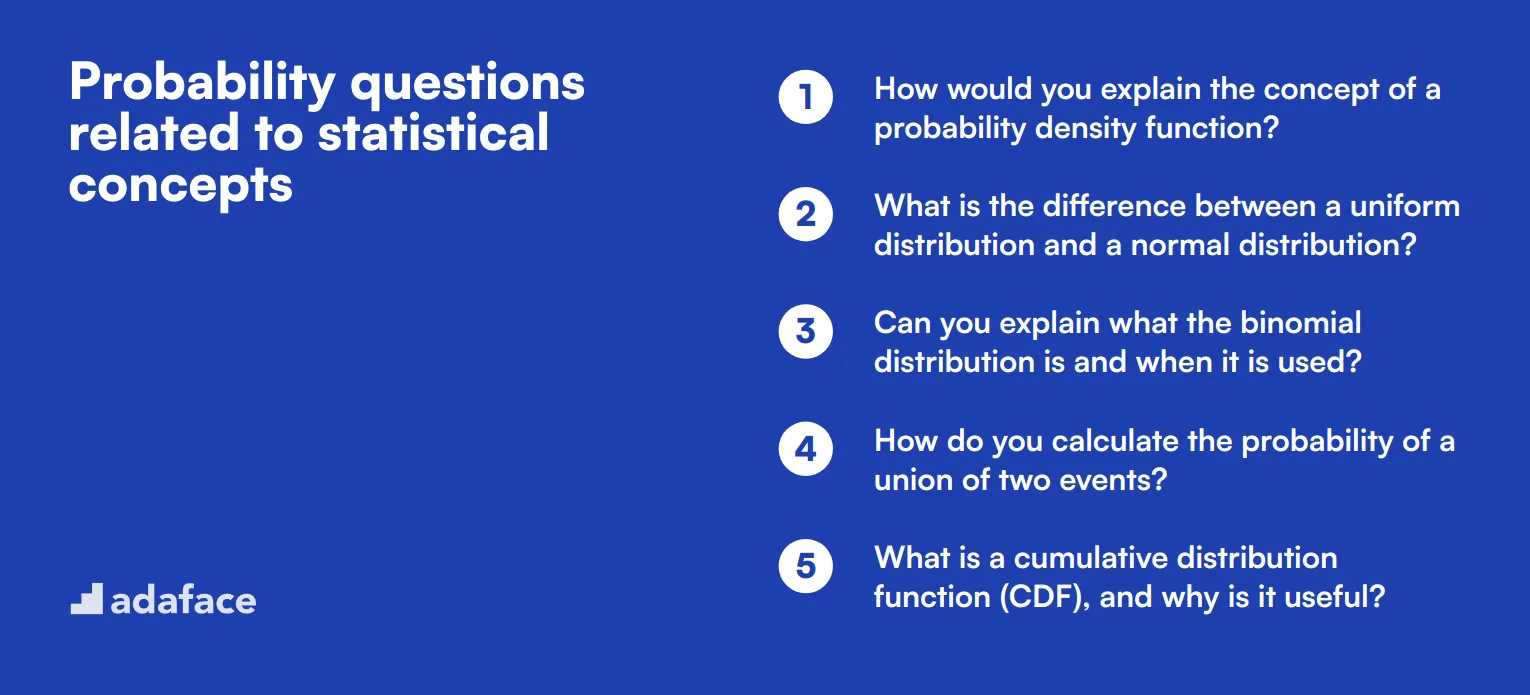
To determine whether your applicants have a solid grasp of statistical concepts in probability, use some of these interview questions. These questions are designed to evaluate a candidate's understanding and application of statistical principles, making them ideal for roles like data analysts and data scientists.
- How would you explain the concept of a probability density function?
- What is the difference between a uniform distribution and a normal distribution?
- Can you explain what the binomial distribution is and when it is used?
- How do you calculate the probability of a union of two events?
- What is a cumulative distribution function (CDF), and why is it useful?
- Can you discuss the significance of the standard deviation in a probability distribution?
- How do you interpret a z-score in a normal distribution?
- What is the difference between point estimation and interval estimation?
- Can you explain what a sampling distribution is?
- How would you use a histogram to represent a probability distribution?
- What is the difference between empirical probability and theoretical probability?
- Can you discuss how the concept of skewness applies to probability distributions?
14 Probability questions related to real-world applications
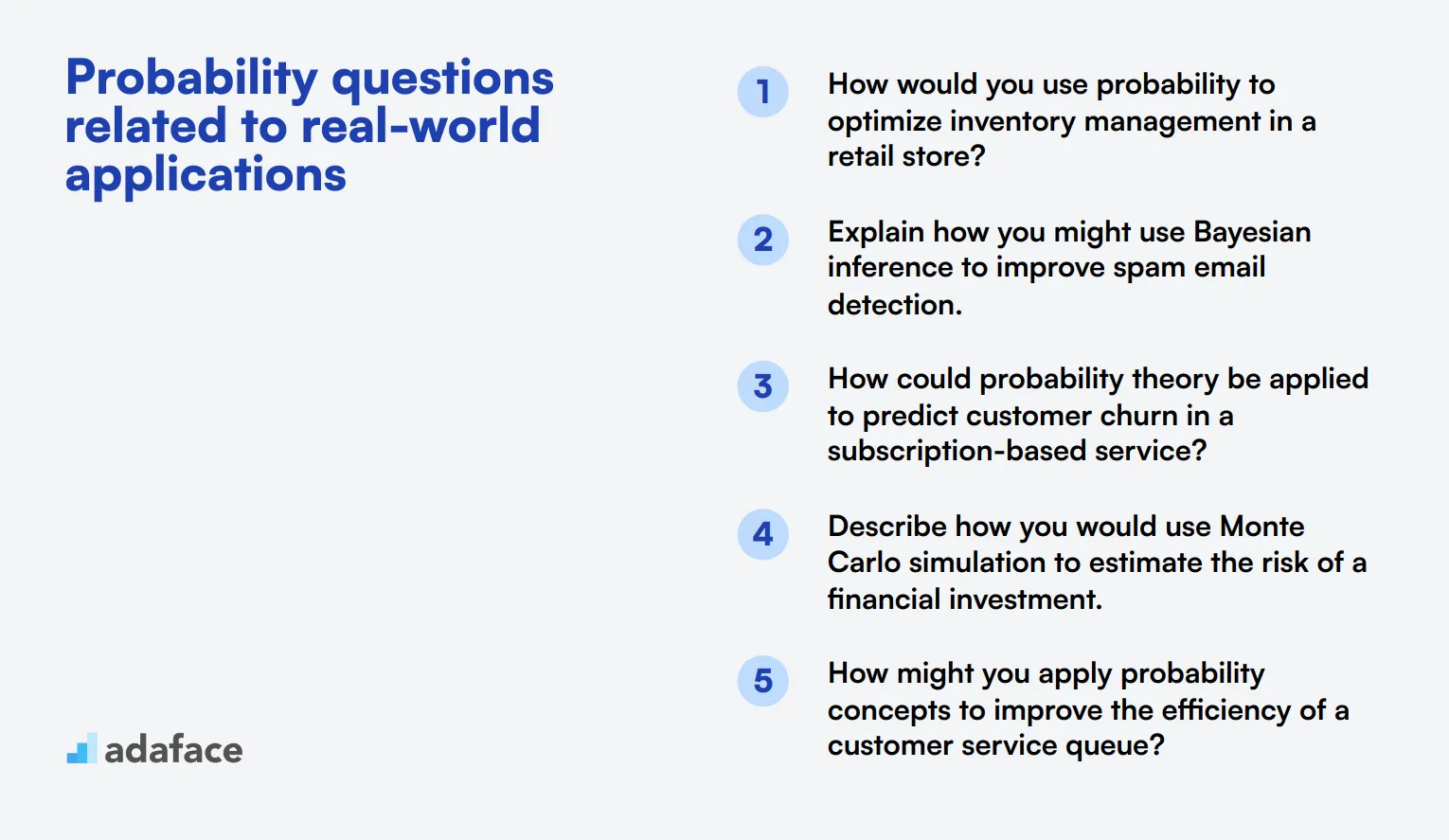
To assess candidates' ability to apply probability concepts to real-world scenarios, consider using these 14 probability questions in your interviews. These questions are designed to evaluate how well applicants can translate theoretical knowledge into practical problem-solving, a crucial skill for roles involving data analysis and decision-making.
- How would you use probability to optimize inventory management in a retail store?
- Explain how you might use Bayesian inference to improve spam email detection.
- How could probability theory be applied to predict customer churn in a subscription-based service?
- Describe how you would use Monte Carlo simulation to estimate the risk of a financial investment.
- How might you apply probability concepts to improve the efficiency of a customer service queue?
- Explain how you would use probability distributions to model and predict website traffic patterns.
- How could probability theory be used to optimize pricing strategies for an airline?
- Describe how you might use Markov chains to analyze and predict user behavior on a mobile app.
- How would you apply probability concepts to improve the accuracy of weather forecasting?
- Explain how you might use Bayesian networks to diagnose machine failures in a manufacturing plant.
- How could probability theory be applied to optimize vaccine distribution during a pandemic?
- Describe how you would use probability to design and analyze A/B tests for a marketing campaign.
- How might you apply probability concepts to improve fraud detection in credit card transactions?
- Explain how you would use probability theory to optimize the placement of emergency services in a city.
Which Probability skills should you evaluate during the interview phase?
While it's impossible to evaluate every aspect of a candidate's probability skills in a single interview, focusing on core competencies can provide valuable insights. The following skills are particularly important to assess during the probability interview phase.
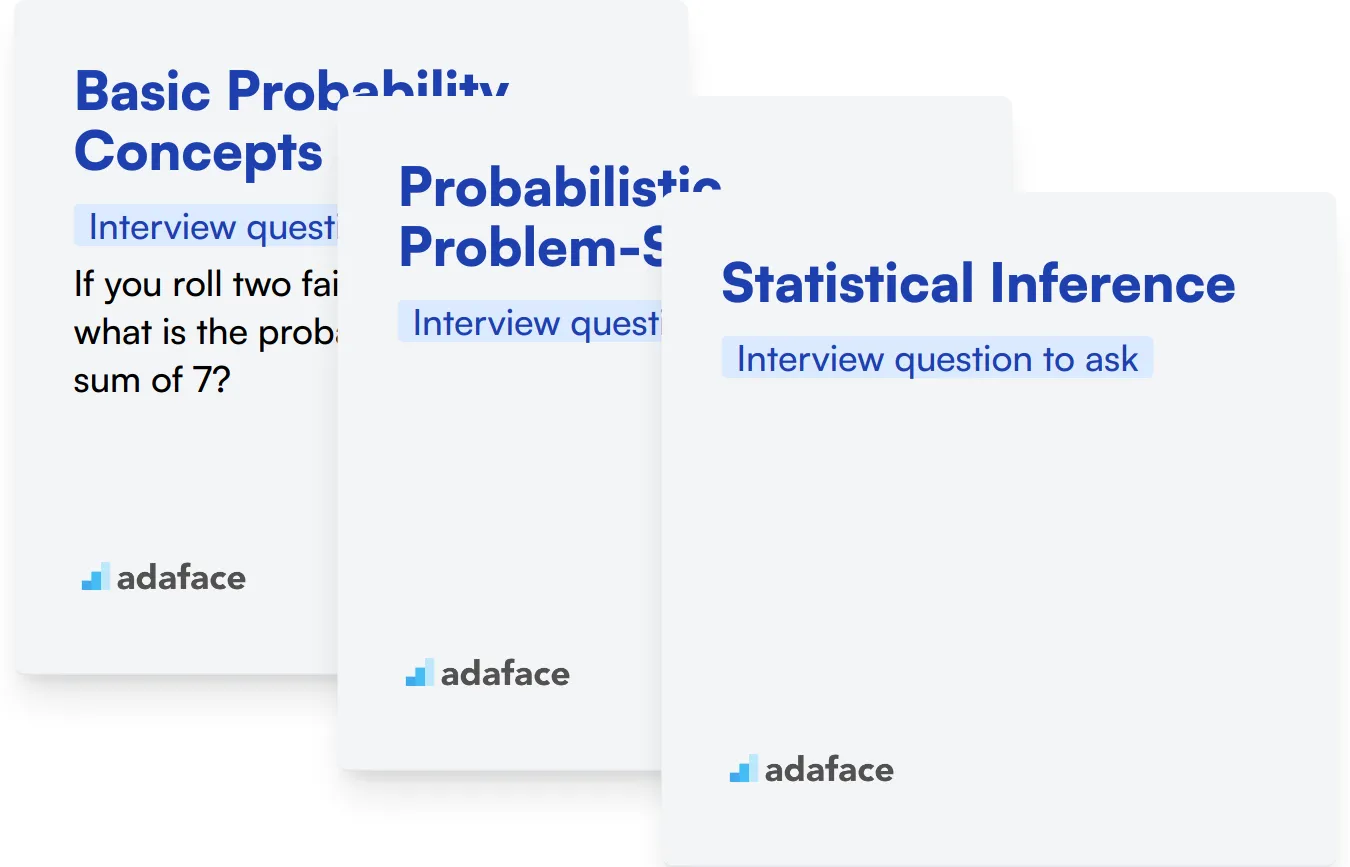
Basic Probability Concepts
Understanding fundamental probability concepts is essential for any analyst or data scientist. This skill forms the foundation for more complex probabilistic reasoning and statistical analysis.
To evaluate this skill efficiently, consider using an assessment test with relevant MCQs. This can help filter candidates based on their grasp of basic probability principles.
During the interview, you can ask targeted questions to gauge the candidate's understanding of basic probability concepts. Here's an example question:
If you roll two fair six-sided dice, what is the probability of getting a sum of 7?
Look for candidates who can clearly explain their reasoning. They should recognize that there are 6 ways to get a sum of 7 (1+6, 2+5, 3+4, 4+3, 5+2, 6+1) out of 36 possible outcomes, leading to a probability of 6/36 or 1/6.
Probabilistic Problem-Solving
The ability to apply probability concepts to solve real-world problems is crucial. This skill demonstrates how well a candidate can translate theoretical knowledge into practical applications.
To assess this skill, present the candidate with a scenario-based question that requires probabilistic reasoning. Here's an example:
A company produces electronic components with a 2% defect rate. If 100 components are randomly selected, what is the probability that at least one is defective?
Evaluate how the candidate approaches the problem. They should recognize this as a complement probability problem, calculate the probability of no defects (0.98^100), and then subtract from 1. The ability to break down complex problems is key.
Statistical Inference
Statistical inference is a critical skill that bridges probability theory and data analysis. It allows analysts to draw conclusions about populations based on sample data.
To assess this skill, you can ask a question that requires the candidate to make inferences based on probabilistic information. For example:
A drug is effective in 70% of cases. In a clinical trial with 100 patients, what is the probability of observing 65 or fewer successes?
Look for candidates who recognize this as a binomial probability problem. They should be able to explain how they would approach calculating this probability, even if they can't compute the exact value without a calculator. Understanding of concepts like normal approximation to binomial distribution would be a plus.
Enhance Your Probability Hiring Process with Skills Tests and Targeted Interviews
When hiring for roles requiring probability skills, it's important to accurately assess candidates' abilities. This ensures you find the right fit for your team and projects.
A practical way to evaluate probability skills is through online assessments. Consider using Adaface's Probability Online Test or Statistics Online Test to gauge candidates' proficiency.
After using these tests to shortlist top performers, invite them for interviews. Use the probability interview questions provided earlier to further assess their knowledge and problem-solving skills.
Ready to streamline your hiring process? Sign up for Adaface to access our probability tests and other assessment tools. For a broader selection of tests, check out our test library.
Probability Test
Download Probability interview questions template in multiple formats
Probability Interview Questions FAQs
The key topics include basic probability, statistical concepts, real-world applications, and questions for different analyst levels.
You can use these questions to assess a candidate's understanding of Probability across different levels of expertise, from junior to senior analysts.
Real-world application questions help evaluate how candidates apply probabilistic concepts to solve practical problems, reflecting their practical knowledge.
Yes, focus on concepts such as distributions, expected values, variance, hypothesis testing, and correlation.
Start with basic questions for junior analysts, intermediate for mid-tier analysts, and advanced questions for senior analysts.
Yes, skills tests can provide a practical assessment of a candidate's abilities, complementing the interview questions for a more holistic evaluation.

40 min skill tests.
No trick questions.
Accurate shortlisting.
We make it easy for you to find the best candidates in your pipeline with a 40 min skills test.
Try for freeRelated posts
Free resources




